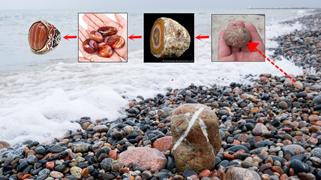Agate is a semi-precious stone primarily composed of microcrystalline quartz (SiO2). It appears in various colors, including white, gray, brown, red, pink, green, blue, and black
How is agate formed, and where can it be found in nature?
✅ Agate is a semi-precious stone primarily composed of microcrystalline quartz (SiO2). It appears in various colors, including white, gray, brown, red, pink, green, blue, and black, with color variations caused by impurities like iron, chromium, copper, titanium, manganese, cobalt, and nickel. Understanding agate's formation stages is essential for locating it in nature.
Agate forms as spherical "nodules" in volcanic rock cavities.
✅ Step 1: When volcanic lava cools, gases create round and oval holes known as "vesicles." Over time, these vesicles merge and enlarge. Underground waters rich in quartz, iron, and other soluble minerals flow through these holes, depositing quartz on their walls and gradually forming opal over millions of years.
✅ Step 2: After millions of years of physical and chemical weathering, agate-containing stone masses detach from their volcanic host rock and are transported by flowing waters to shorelines and riverbanks. There, they appear as rounded or egg-shaped masses. Breaking these stones reveals agate and its bands.
✅ Thus, sandy beaches of seas and lakes are ideal locations for agate exploration.


